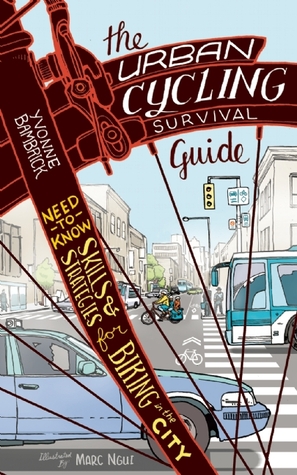Like this article? Chip in to keep stories like these coming.
![]()
I consider myself an amateur bike rider: I like biking as a fun and pragmatic activity, I feel somewhat confident on the road and I can definitely see the health and environmental benefits of it. However, I don’t know how to fix a flat tire and I still generally fear for my life on busy streets.
If this sounds familiar, or if you’re just a fresh-faced beginner looking to get into biking, then Yvonne Bambrick’s The Urban Cycling Survival Guide: Need-to-Know Skills and Strategies for Biking in the City is definitely for you.
Bambrick, the founding executive director of the Toronto Cyclists Union (now Cycle Toronto), has created an essential reference guide for urban cyclists. It provides straightforward and digestible information about how to incorporate urban biking, on any scale, in any city, into your life.
Useful sections range from “Gearing Up,” complete with an illustrated guide for finding the right bike for you, to “Basic Maintenance,” which taught me how to change that pesky flat tire.
The meat of this book comes in “Navigating the Streetscape,” a highly detailed and illustrated section that shows the rider how to get on the road safely. It is a veritable cornucopia of useful information and it can be used as a complete course or quick refresher for any rider.
Bambrick explains the most need-to-know facts for cyclists to feel comfortable on the road including the four basic maxims of vigilance (scan, anticipate, evade, correct), the difference between bike lanes and how to use them and hilarious “rules to stay alive.” She emphasizes that urban cycling is about being smart, claiming your space and staying alert and aware at all times.
Bambrick’s understanding of her audience and that to beginners and moderates, urban cycling, and bike culture in general, can be overwhelming and downright terrifying, is what makes this book great. Instead of emphasizing the scariness, she invites the reader in with her cheery tone and persistent encouragement (“you don’t need to be a ‘cyclist’ to ride a bike!”) and provides a very real counter-argument to the perception that it’s really dangerous to commute by bicycle.
She thoughtfully details how to navigate common roadway scenarios and how best to avoid potential obstacles and keep safe, making the reader feel confident. “Bicycling is actually similar in safety to walking. And evidence shows that its health benefits far outweigh any injury risks,” writes Bambrick.
I would argue that the biggest hurdle for most new urban cyclists is this fear of injury. Knowledge of and obeying traffic rules and cycling infrastructure play a huge role in keeping bikers safe and Bambrick devotes some much-needed space to this.
She is also quick to remind everyone that “your vulnerability is real on a bicycle and shouldn’t be underestimated” underscoring the duality of urban cycling. There is also an extensive, highlighted and bolded section entitled “Sharing the Road as a Driver” and it is… absolutely infuriating, to no fault of Bambrick’s own.
Full disclosure: I’m a car-hater. I think they’re mobile death machines and you can’t convince me otherwise. Regardless, when it needs to be stated to “check your mirrors — you’ve got to shoulder check as well” or “prior to making a right-hand turn, signal and check your right-side mirrors and blind spot,” you should not be allowed to drive a car, full stop. Driving a car (re: mobile death machine) is a privilege not a right.
Bambrick does do an admirable job of tempering this battle for the road, choosing encouragement over scolding, but this whole section really illustrates the crux of the issue of cars. vs bikes: cars don’t see bikes as legitimate road vehicles and therefore don’t respect them.
If we want to make change in our cities and address the seriousness of congestion and climate change, we need to embrace the bicycle and build and improve cycling infrastructure. The popular misconception that bicycles only serve a minority population is beyond wrong and North American cities, and drivers, need to adapt.
Ridership in North America is steadily climbing thanks in some part to bike-share programs and definitely to dedicated cycling infrastructure. “When protected bike lanes are added to a street, bike traffic rises — by an average of 75 per cent in their first year alone,” writes Bambrick. Vancouver just passed one million riders on the Burrard Bridge almost one year after a protected bike lane was installed.
And more to the point, cycling infrastructure is “cheap and easy to build and it’s more taxpayer friendly,” writes April Economides, president of Green Octopus Consulting. Staggering stats from Portland, Oregon prove this: its 300-mile (482 km) bike network cost the same amount as one mile (1.6 km) of freeway.
More cycling infrastructure means more cyclists and more safety in numbers. It means less traffic congestion and less air pollution and more money for the local economy and a happier population. Now that sounds nice, doesn’t it?
Urban cycling is not an overwhelming, insurmountable task or a niche interest for the elite cyclists. It is a doable and even enjoyable pursuit! Bambrick’s passion and enthusiasm made me confident I could be a better cyclist and The Urban Cycling Survival Guide showed me how.
Grab a copy and get inspired by urban cycling. Happy riding!
Kaitlin McNabb is rabble’s books and news coordinator. Follow her on twitter @kaitlinmcnabb.



